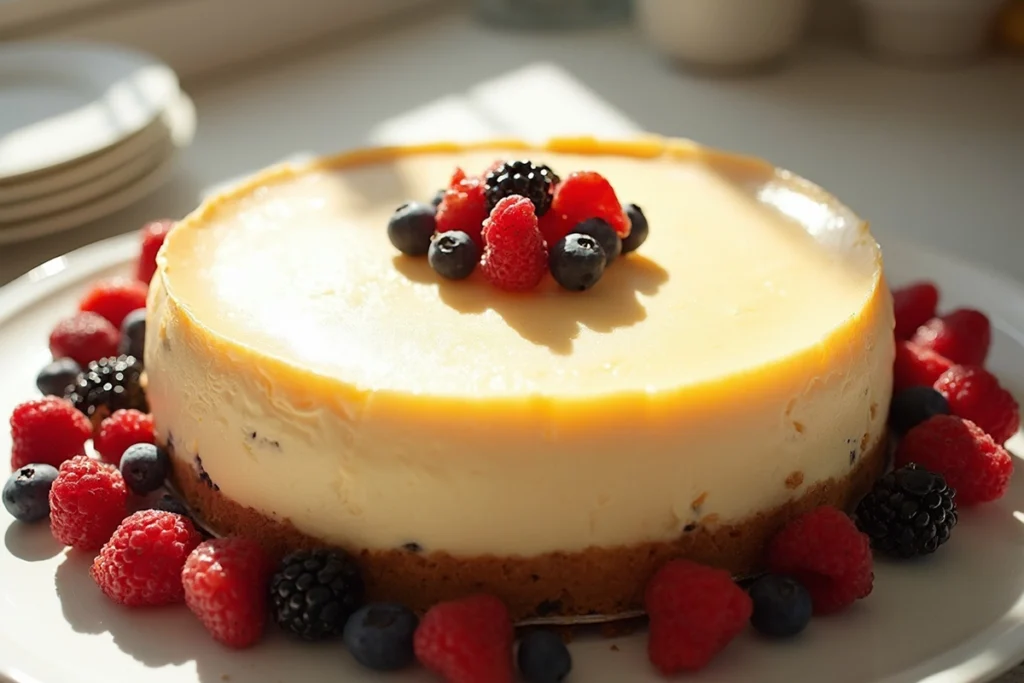Cheesecake is a beloved dessert worldwide, admired for its creamy texture and rich flavor. However, achieving the perfect cheesecake can be tricky. Bakers often wonder, what is the secret to the best cheesecake? This guide will reveal the best tips and tricks to make your cheesecake stand out, ensuring you achieve that silky, smooth, and crack-free result every time.
1. Use Full-Fat Ingredients for Creaminess
To achieve the best texture in cheesecake, it’s crucial to use full-fat cream cheese, sour cream, and eggs. Reduced-fat alternatives will not give the same richness and smoothness that full-fat ingredients provide.
- Why full-fat is important: Full-fat cream cheese offers a creamier consistency, while sour cream adds a subtle tang. Eggs help bind everything together, creating a firm, luscious texture.
- No shortcuts: Avoid using low-fat substitutes if you want a truly decadent cheesecake. Low-fat products can result in a cheesecake that’s rubbery or less flavorful.
For those looking to create a gluten-free version, explore this guide on gluten-free cheesecake recipes for full-fat but dietary-friendly options.
2. Room Temperature Ingredients: The Secret to Smooth Batter
One of the keys to making the best cheesecake is using room temperature ingredients. Cold cream cheese, eggs, and sour cream will not blend smoothly, which can cause lumps in your batter.
- Tip: Take your ingredients out of the refrigerator at least 30 minutes before starting the recipe. If you forget, you can soften cream cheese quickly by cutting it into cubes and letting it sit at room temperature for 10–15 minutes.
- Importance of smooth batter: Lumps can result in an uneven texture and inconsistent baking.
3. Perfecting the Crust: Foundation of a Great Cheesecake
A sturdy, flavorful crust is essential for balancing the richness of the cheesecake filling. The most common cheesecake crust is made from graham crackers, but you can experiment with other cookies or nuts.
- Tip: Crush your graham crackers or cookies into fine crumbs, then mix them with melted butter to ensure the crust holds together when sliced.
- Enhance flavors: Add a pinch of cinnamon or lemon zest to the crust mixture for added depth and flavor.
For ideas on using different gluten-free crust options, check out this comprehensive guide on gluten-free desserts.
4. Mixing the Batter Properly: Avoid Overmixing
Properly mixing the batter is a crucial step in creating the best cheesecake. Overmixing can lead to cracks because it introduces too much air into the batter.
- Mix in stages: First, cream the cheese and sugar together until smooth. Then, add the eggs one at a time, mixing just until combined. This method ensures a silky batter without excess air.
- Don’t rush: Scrape down the sides of your bowl to ensure everything is evenly mixed.
5. Baking with a Water Bath: Preventing Cracks
A water bath, or bain-marie, is a secret weapon to achieving the best cheesecake texture without cracks. The water bath creates a moist, gentle environment that helps the cheesecake bake evenly.
- How to set it up: Wrap the bottom of your springform pan in aluminum foil to prevent water from seeping in. Place the pan in a larger baking dish filled with hot water, about halfway up the sides of the springform pan.
- Why it works: The steam from the water bath prevents the surface from drying out and cracking.
For further tips on baking cheesecakes with water baths, visit Taste of Home’s cheesecake tips.
6. Avoiding Common Baking Mistakes
Avoiding common mistakes can make all the difference in the outcome of your cheesecake.
- Overbaking: Overbaking is the most common cheesecake mistake. The center of your cheesecake should still have a slight wobble when you remove it from the oven.
- Oven placement: Bake the cheesecake on the lower oven rack to prevent the top from browning too quickly.
- Do not open the oven door early: Opening the oven door prematurely can cause drastic temperature changes, leading to cracks.
Learn more about avoiding baking mishaps in cheesecakes at Angelina Recipes’ guide to perfect cheesecake.
7. Cooling and Refrigerating: Letting It Set Properly
Once your cheesecake is baked, the cooling process is just as important.
- Cool gradually: Let the cheesecake cool on a wire rack for an hour before transferring it to the fridge. This helps prevent cracks.
- Refrigerate overnight: Cheesecake needs time to set properly. Refrigerating it for at least 4 hours, preferably overnight, gives the flavors time to develop and ensures the perfect texture.
Proper refrigeration is a critical step in creating the best cheesecake. For more cooling tips, visit Angelina Recipes’ guide on how to set cheesecake perfectly.
8. Topping and Decorating Your Cheesecake
Toppings can elevate your cheesecake’s presentation and flavor.
- Fruit toppings: Fresh berries, like strawberries or raspberries, add a burst of color and a refreshing contrast to the rich filling.
- Drizzles and sauces: A drizzle of caramel, chocolate ganache, or fruit purée can transform your cheesecake into a work of art.
- Covering cracks: If cracks do form, use whipped cream, fruit, or sauces to disguise them.
For gluten-free topping ideas, take a look at this guide on gluten-free dessert toppings.

FAQs
What makes a cheesecake creamy?
The secret to a creamy cheesecake is using full-fat ingredients like cream cheese and sour cream. These ingredients provide the richness that defines a good cheesecake.
How do I prevent cracks in my cheesecake?
To prevent cracks, always use a water bath, avoid overmixing, and let the cheesecake cool slowly before refrigerating.
Can I use low-fat cream cheese?
You can, but the texture and richness may be compromised. Full-fat cream cheese is best for achieving a creamy, indulgent cheesecake.
How long should I refrigerate my cheesecake before serving?
For the best texture, refrigerate your cheesecake for at least 4 hours, but overnight is ideal.
Conclusion
So, what is the secret to the best cheesecake? It’s all about mastering the small details—using full-fat ingredients, avoiding overmixing, baking with a water bath, and giving the cheesecake ample time to set in the refrigerator. By following these tips, you can create a cheesecake that is rich, creamy, and utterly indulgent.
For more cheesecake tips and ideas, visit Angelina Recipes to explore more ways to perfect this classic dessert.

